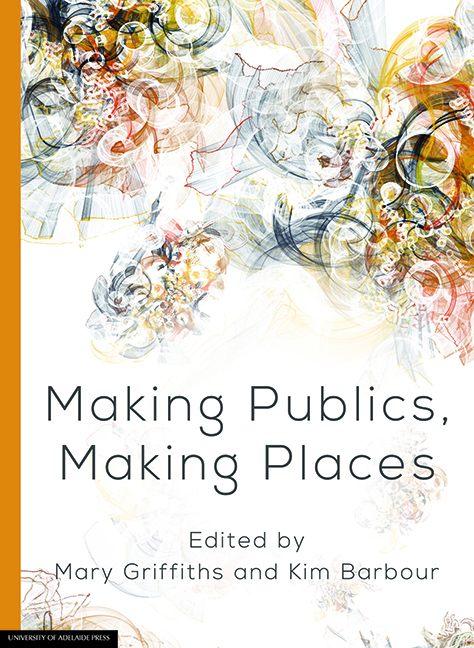Book contents
- Frontmatter
- Contents
- Preface
- Abstracts
- List of contributors
- 1 Making publics, making places
- 2 The elasticity of the public sphere: Expansion, contraction and ‘other’ media
- 3 ‘Imagine if our cities talked to us’: Questions about the making of ‘responsive’ places and urban publics
- 4 Picturing placelessness: Online graphic narratives and Australia's refugee detention centres
- 5 Reclaiming heritage for UNESCO: Discursive practices and community building in northern Italy
- 6 Find your Adelaide: Digital placemaking with Adelaide City Explorer
- 7 Chinese films and the sense of place: Beijing as ‘Thirdspace’ from In the Heat of the Sun to Mr Six
- 8 Social media and news media: Building new publics or fragmenting audiences?
- 9 The use of Chinese social media by foreign embassies: How ‘generative technologies’ are offering opportunities for modern diplomacy
- 10 An opinion leader and the making of a city on China's Sina Weibo
- 11 Public audiencing: Using Twitter to study audience engagement with characters and actors
- 12 Overcoming the tyranny of distance? High speed broadband and the significance of place
8 - Social media and news media: Building new publics or fragmenting audiences?
Published online by Cambridge University Press: 28 July 2017
- Frontmatter
- Contents
- Preface
- Abstracts
- List of contributors
- 1 Making publics, making places
- 2 The elasticity of the public sphere: Expansion, contraction and ‘other’ media
- 3 ‘Imagine if our cities talked to us’: Questions about the making of ‘responsive’ places and urban publics
- 4 Picturing placelessness: Online graphic narratives and Australia's refugee detention centres
- 5 Reclaiming heritage for UNESCO: Discursive practices and community building in northern Italy
- 6 Find your Adelaide: Digital placemaking with Adelaide City Explorer
- 7 Chinese films and the sense of place: Beijing as ‘Thirdspace’ from In the Heat of the Sun to Mr Six
- 8 Social media and news media: Building new publics or fragmenting audiences?
- 9 The use of Chinese social media by foreign embassies: How ‘generative technologies’ are offering opportunities for modern diplomacy
- 10 An opinion leader and the making of a city on China's Sina Weibo
- 11 Public audiencing: Using Twitter to study audience engagement with characters and actors
- 12 Overcoming the tyranny of distance? High speed broadband and the significance of place
Summary
Introduction
Social media present both opportunities and threats for news media, affecting their relationships with their publics and the geographical places and spaces that they have traditionally served. Social media provide opportunities to create and expand audiences, increase geographical reach, respond more quickly than ever before to news events and issues, and interact with news consumers in more immediate and direct ways. Consequently, they may enable news media to develop new publics and shift understandings of their relationships with place. However, news outlets’ capacity to respond to these opportunities may be limited by competition for audience from non-traditional news providers, dispersal of demand, and as-yet limited opportunities to profit from social media engagement. Further adding to the complexity of the picture is that these opportunities and challenges are occurring at a time when the news media are in a state of flux more broadly, with the destruction of established business models, the fracturing of audiences and the widely heralded demise of print newspapers threatening the ongoing profitability — and in many cases viability — of news organisations. The threat to newspapers is particularly profound: McCombs et al. describe them as having been in perilous decline for many decades (2011), but the decline has been hastened more recently by technological and societal developments that have both severely impacted their capacity to sustain themselves through advertising and dispersed audience demand for news and information.
At the same time as capacities for information distribution have expanded and audience expectations of instant, ubiquitous access to news have continued to grow, declining profitability has resulted in large-scale and ongoing redundancies (see, for example, New beats, n.d.; Paper cuts, n.d.). This declining resourcing puts newsrooms and journalists under severe and constant pressure — pressure that may be felt even more intensely in newsrooms outside major cities, as non-metropolitan newsrooms have traditionally operated with relatively few resources. A small number of journalists have to cover not only a wide range of news topics, but also, in countries such as Australia, a geographical territory that may span thousands of square kilometres. Further adding to the complexity of the news environment in regional areas are the historically strong relationships between audiences and traditional news products, which may limit both incentive and opportunity to comprehensively utilise online platforms.
- Type
- Chapter
- Information
- Making Publics, Making Places , pp. 129 - 144Publisher: The University of Adelaide PressPrint publication year: 2016



